Home Camera Articles FOR SALE Orders I Buy / Wants Repairs Books Adapters
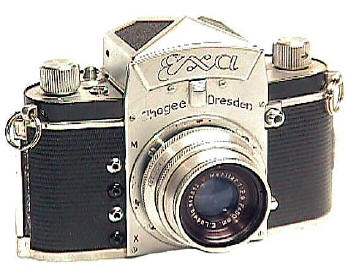
Home Camera Articles FOR SALE Orders I Buy / Wants Repairs Books Adapters

The Original Exa
Exakta's little brother
The Exa pioneered the low cost SLR companion to the full featured SLR -- something still played out today with the likes of the Nikon N60 and F5, or Canon Rebel and EOS 1n.

The inexpensive little Exa of 1952 afforded many beginning photogs an entry into the world of SLR photography. Taking many of the same lenses and accessories of the best selling SLR of the day, big brother Exakta, the little Exa was smart marketing and smart photography.
20/20 hindsight shows the Exa in an increasingly good light as an important part of Exakta and 35mm history. Introduced as a low cost alternative to what the time was the world's leading 35 SLR, the little Exa paled besides the full blow full featured SLRs, but shined against comparably priced and less able non-SLR competition like the best selling but much more limited Argus C3.
 Your eyes
are not deceiving you. In the up position, the mirror chamber
is blocked off from the front, and open from the back, because the original Exa's shutter
IS the mirror. While this design simplified design and lowered cost,
shutter speeds were limited to a range of 1/25th to 1/150th plus B. With
today's electronic marvels have the very useful shutter ranges of 30 seconds
to 1/12,000th seconds (I use speeds higher than 1/1000th or lower than 1/15th for all my
shots), many people can actually get by with this limited five speed shutter speed
range. That reminds me of those funny little throwaway cameras sold in grocery
stores for $10 that have only one shutter speed, but take millions of pictures each year.
Your eyes
are not deceiving you. In the up position, the mirror chamber
is blocked off from the front, and open from the back, because the original Exa's shutter
IS the mirror. While this design simplified design and lowered cost,
shutter speeds were limited to a range of 1/25th to 1/150th plus B. With
today's electronic marvels have the very useful shutter ranges of 30 seconds
to 1/12,000th seconds (I use speeds higher than 1/1000th or lower than 1/15th for all my
shots), many people can actually get by with this limited five speed shutter speed
range. That reminds me of those funny little throwaway cameras sold in grocery
stores for $10 that have only one shutter speed, but take millions of pictures each year.
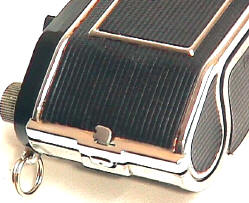
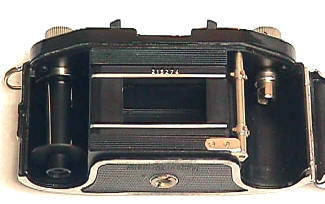
The back swings back for easy loading, just like big brother Exakta. In the age where Leicas were the best selling pro 35's cameras and were relatively difficult to load, easy loading was a big plus -- especially for the beginner this camera was designed for. The push down latch on the left edge of the back door opened the camera back. Notice high quality chrome and body covering for such an inexpensive camera -- it seems to be identical to big brother. By showing beginning buyers the entry level Exa was a well made camera, Ihagee inspired confidence in the line and gained future customers -- smart marketing.
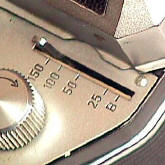

The top deck has lever with an open body cavity to select the shutter speeds -- a strange design presumably dictated by the Exa's mirror shutter. The Exa's small knob winds for film advance and film rewind are not particularly convenient. The film counter near the button shutter release has to be manually reset, unless you want to get to the end of your roll when your counter says frame 3.
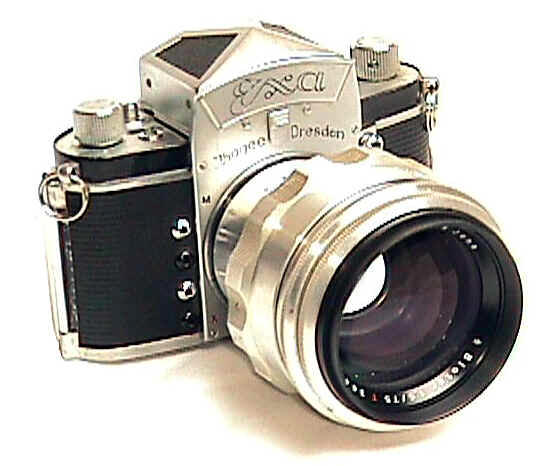
Yes indeed, though the little Exa was often sold with miserable 3 element lenses
to keep the cost down, you could use it with the higher level lenses, but within the 35 to
100mm range. The 75/1.5 Biotar on the Exa makes more sense than you might
think. The Exa's unique shutter is very quiet in a
properly adjusted and lubricated camera. So quiet, it makes sense to use it in low
light environments where silence is an asset.
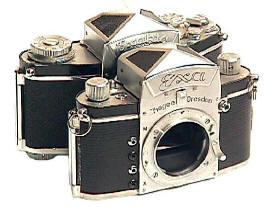

The Exa is noticeably smaller, but similar in shape, to big brother Exakta VX IIa. By the way, if you believe I shoot most of my pics with shutter speeds lower than 1/15th or higher than 1/1000th, perhaps a refresher course of Photography 101 would be useful.
Exas Exas Everywhere
Exas were quite successful commercially. The Exa line lived on to 1966 with the Exa 500, though at least 7 different major models with 18 or more different variations. One confusing part is that many variations noticed by collectors share the same factory designation. To muddy the waters more, collector books can disagree upon Exa model terminology. I have called the first model Exa the "original," since using the factory term "Exa" has a tendency to confuse it with the larger Exa lineup. Collecting all of them can be challenging, and must less expensive than all the Leicas or Nikons. The biggest Exa dividing line is between the earlier mirror shuttered versions and the later Exa II versions with a traditional focal plane shutter -- and larger shutter speed range.
Home Camera Articles FOR SALE Orders I Buy / Wants Repairs Books Adapters
Revised: November 25, 2003 . Copyright � 1998-2002 Stephen Gandy. All rights reserved. This means you may NOT copy and re-use the text or the pictures in ANY other internet or printed publication of ANY kind. Information in this document is subject to change without notice. Other products and companies referred to herein are trademarks or registered trademarks of their respective companies or mark holders.